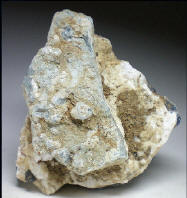
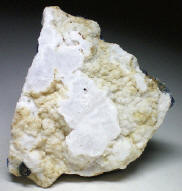
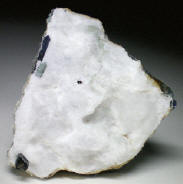
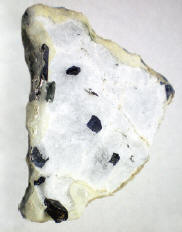
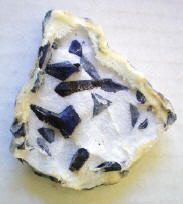
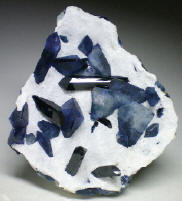
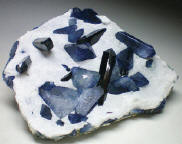
Photo sequence showing stages of preparationfrom rough rock to finished specimen,size 7.5 cm. Specimen and photosJ. Veevaert.
Most of the natrolite veins are lessthan 2 cm thick. The minerals of interestat the mine are confined to the vein systemsand frequently are attached to bothvein walls. This creates an obvious problemduring specimen preparation as oneside of the vein has to be mechanicallyremoved to permit a chance at producinga specimen.
Though the lower level portionsof the vein system were typically filledwith natrolite, some pockets were leftintact. These pockets typically displayblocky natrolite crystals and in somecases neptunite and benitoite crystalsare still exposed. The size of these pocketsis generally quite small, rarelyexceeding 2 cm in size. As mentionedearlier, the upper zone is devoid ofnatrolite. All minerals found in that zonetend to be hidden only by clay mineralswhich can be easily removed withwater. Although pocket zones werestill not large, and mineralization wasmuch more scattered in the upper zone,the crystal quality of benitoite andjoaquinite is much higher not havingbeen subjected to the natrolite-bearingsolutions.
MINERALS FROM
THE BENITOITE GEM MINE
Benitoite (TL) – BaTiSi3O9
Benitoite is the primary mineralof interest from this deposit. It is a ringsilicate and crystallizes in the hexagonalcrystal system. Early in the theoreticaldevelopment of crystallography it washypothesized that there was a classof the hexagonal system that wouldproduce trigonally shaped crystals. Thediscovery of benitoite provided the mineralworld with the first species knownto crystallize in the ditrigonal-dipyramidalclass of the hexagonal crystalsystem. This class is referred to as the“Benitoite Type” in Dana. Twinningof benitoite occurs as 180 degree rotationabout the c-axis (0001). An equidimensionaltwinned crystal is referd to asa "Star of David" owing to its perfectsix sided star. Twinning has only beenfound in benitoite crystals included withcrossite. Complete crystals of this formare very rare.
Benitoite is found in two classes atthe mine – as euhedral, floater crystalsheavily included with amphibole minerals(commonly referred to as “rockies”),and as crystals firmly attached to thevein walls. It is from rocks of the latterclass that the best gem benitoite hasbeen recovered. The crystal faces of benitoitewere selectively etched during thenatrolite phase of mineralization. Rareexamples of crystals exist with all brilliantlylustrous faces, but in most benitoitethe c face and prism faces retainedtheir luster while the pyramidal faces became duller due to etching during thenatrolite mineralization. The averagecrystal sizes for non-included benitoiteis between 0.5 and 1.0 cm. Crystals over2 cm across are considered large andany crystal over 3 cm across is considered to be very large (and exceedinglyrare). Crystals with crossite inclusionscan be quite large at up to 5-6 cm acrossbut the crystal form is typically mottledin crystals greater than 2-3 cm.
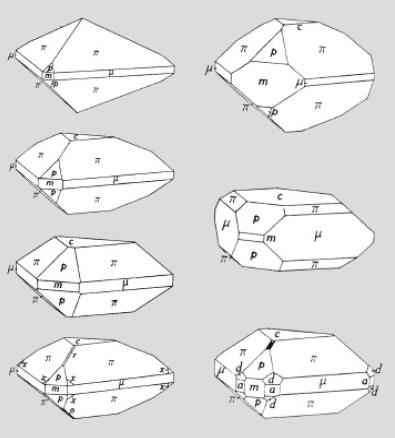
Crystallographic drawings showing thevarious crystal habits and forms of benitoite. From Louderback, 1909.
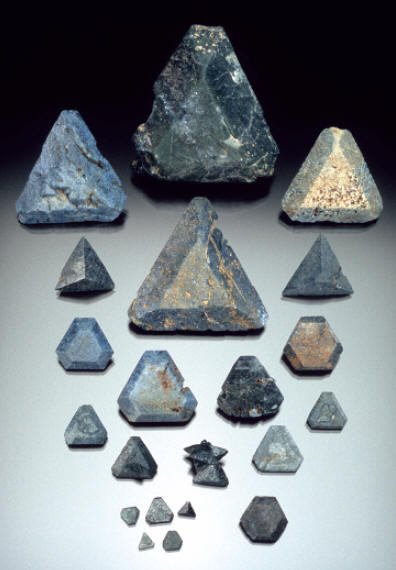
Group of benitoite crystals showing different forms, size up to 4.5 cm. B. Gray specimens. J. Scovil photo.
Not all benitoites are the same color.
While the more popular color is a richsapphire blue with a hint of violet, benitoitemay also be clear, white, pink, reddishbrown or greenish-gray colors aswell. The origin of the color of benitoitehas not been completely determinedas of yet. The chemical compound doescontain traces of iron, hence it has been proposed that color may be due to theFe2+:Ti4+ or the Fe2+:Fe3+ intervalancecharge transfer. Joan Mamarella (personalcommunication 1997) suggestsin her thesis that the blue color isderived from the titanium in the blueportions of the crystals being paramagneticwhile the titanium in the whiteportions are diamagnetic. Benitoite isalso frequently found as gray to greenishcolored crystals with very dense inclusionsof crossite. The vast majority of crossite included crystals are floaterswith complete terminations on bothends. Some crystals of benitoite appearred to dark maroon due to inclusionsof minute neptunite crystals.
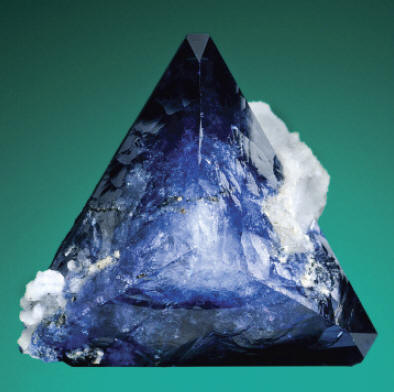
Superb, lustrous (probably free growing) benitoite crystal, 2.5 cm wide. J. Sigerman specimen. J. Scovil photo.
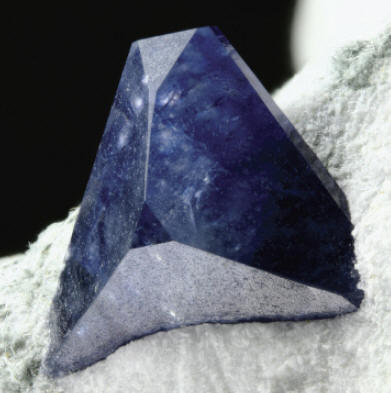
Benitoite crystal, 1.2 cm wide. M. Chinellato specimen and photo.
Pink crystals of benitoite have beenfound at the Mine Numero Uno situatedseveral kilometers from the BenitoiteGem mine. The origin of this color is unknown.
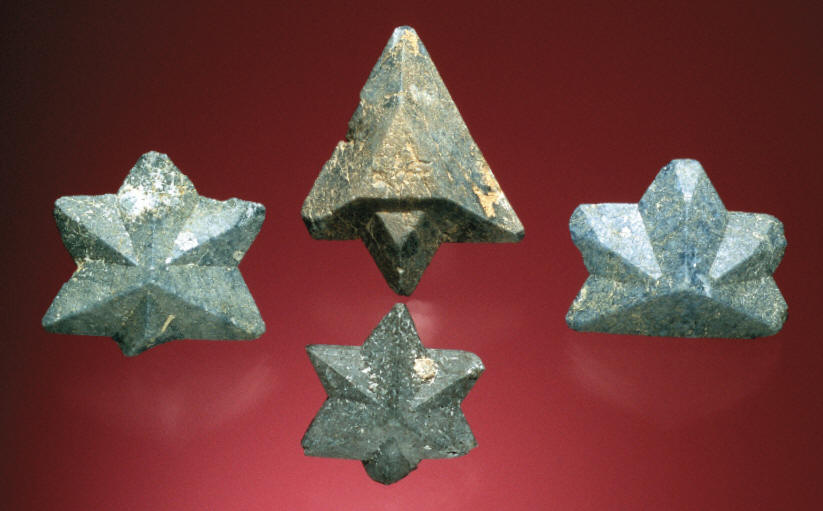
Twinned benitoite crystals up to 3.3 cm. B. Gray specimens. J. Scovil photo.














 YueGongAnBei 44051102000467
YueGongAnBei 44051102000467


 |
|